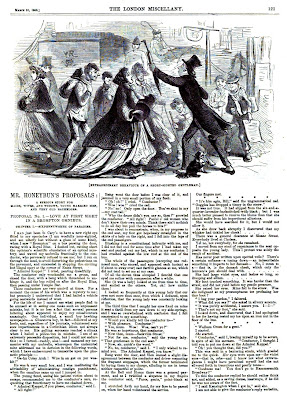 |
| Wild Oats – subtitled “An Illustrated Weekly Journal of Fun, Satire, Burlesque, Hits at Persons and Events of the Day.” – cover by C.J. Howard, No. 28, Vol. III, April 11, 1872. |
by Richard Samuel West
The dominant humor magazine in America in the 1870s was Wild Oats. When it was launched as a monthly in February 1870, in New York, it joined a crowded field. Four other folio monthlies were by that time well-established. Frank Leslie’s Budget of Fun (1859-78), The Comic Monthly (1859-81), and Phunny Phellow (1859-73) were all over a decade old. The Jolly Joker (1866-78) was nearing its fiftieth issue. None of them was particularly healthy (though the Budget of Fun was still the best of the four), but New Yorkers were well accustomed to seeing them around town. There were also three comic quartos that vied for the railroad passenger crowd, Yankee Notions (1851-75), Nick-Nax (1856-75), and Merryman’s Monthly (1863-75). They had all seen better days. So when Wild Oats hit the newsstands it actually stood a good chance of success.
It was edited by 35-year-old George Small, aka Bricktop, perhaps the most prolific comic writer of the post-Civil War period. Born in Maine, raised in Massachusetts, the eldest in a family of nine children, Bricktop earned his sobriquet due to his shock of (rapidly thinning) red hair. He was a gentle humorist, a specialist of the mildly amusing yarn told at a glacial pace. Previously he had been the editor of The Jolly Joker, both when it was owned by the Leslie brothers, Alfred and Henry, and then after they sold it to their father Frank Leslie in the summer of 1868. Bricktop had joined with the advertising manager of The Jolly Joker, Jinks Winchell, to establish Wild Oats. Winchell was a half-dozen years younger than Bricktop. He (and his mother) boarded with the Bricktop, his wife, and child in a New York City rooming house.
Thomas Worth, C.J. Howard (not to be confused with the more talented J.H. Howard), and the youthful Livingston Hopkins, fresh to New York City from his native Ohio. As a sign of its success, after two years as a monthly, the owners converted Wild Oats to a fortnightly, just in time for the 1872 presidential campaign. The magazine did not seem to care one way or the other about President Grant, but it vilified Horace Greeley. More talent came Wild Oats’ way. By the turn of the year, Mike Woolf, Frank Bellew, Frank Beard, and W.H. Shelton were contributing cartoons and John Harrington, writing as ‘John Carboy,’ and ‘Tom Wonder’ were contributing fiction.
In November of 1872, for reasons unknown, Winchell dropped out as co-owner and was replaced by 30-year-old John Collin (no ‘s’), a New York printer. Usually when this happened in 19th century journalism, it meant that the publisher could not keep up with the printing bills and in lieu of payment deeded over his share of the magazine to the magazine’s printer. While this seems the likely explanation for Winchell’s departure and Collin’s arrival, it would have been considered a surprising development since by all appearances Wild Oats was prospering.
In early 1874, James A. Wales, following in the footsteps of his fellow Ohioan Hopkins, began drawing for the magazine. Frank Bellew stepped up his contributions when The Fifth Avenue Journal, the Democratic weekly he had been working for, fell on hard times and eventually folded. On the literary side, sometime during the year, John Harrington became assistant editor. In October, Collin and Small converted Wild Oats into a weekly, making it the only comic weekly magazine in America at the time.
Yet another Ohioan, Frederick Burr Opper began contributing cartoons in October 1875. His work figures prominently in the magazine in 1876, especially after Wales departed for study in Europe and Bellew fell ill for much of the year. Wild Oats pulled off something of a literary coup in August when it pirated a chapter of Mark Twain’s forthcoming novel, already published in England. It became the first magazine in America to publish ‘How Tom Sawyer Got His Fence Whitewashed’ in the August 23 issue, several weeks before Tom Sawyer was published in New York. In the fall, Wales joined the staff of Frank Leslie’s, replacing Joseph Keppler, who had left to found the German-language Puck. Not long after, Opper would join Wales at Leslie’s. By the end of the decade, both of them were lured away by Keppler to help him illustrate the increasingly prosperous Puck.
 |
| Wild Oats, No. 181, Vol. XIV, June 14, 1876 front page. Cover by F. Opper satirizing fellow cartoonist Thomas Nast’s anti-Catholic fixation. |
[ Postscript ] Bricktop was not done. After departing Wild Oats, he formed a partnership with Frank Tousey, a story paper publisher, and they appeared to prosper. In 1881, they made a bold move to challenge Puck’s supremacy. Gathering the old staff of Wild Oats from its heyday, Bricktop and Tousey hired Wales away from Puck and enlisted the talents of Livingston Hopkins and Thomas Woolf, both freelancing at the time, to found The Judge. It was initially a success and all looked bright, but before long the new venture faltered. Tousey sold out, Bricktop moved on, Worth joined the staff of Texas Siftings, Hopkins absconded to Australia, Wales quit, and the magazine teetered on the brink. In 1886, however, it was purchased with GOP money by W.J. Arkell a newspaperman from upstate New York, and it roared once more to life. But that is another story. By then, Bricktop was gone, dying of consumption at the age of 51 on March 10, 1886. Aside from his countless books, he had steered the fates of three American humor magazines, The Jolly Joker in the 60s, Wild Oats in the 70s, and The Judge in the 80s. The Judge would last the longest (until 1947), but Wild Oats would be his crowning comic contribution.































































